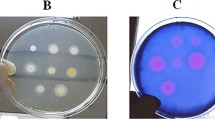Abstract
Isolates of 17 strains of epidemic methicillin-resistant Staphylococcus aureus from outbreaks in ten hospitals in the UK were investigated with a variety of techniques both to explore their properties and to type them in order to confirm or refute known or suspected epidemiology. The techniques consisted of a biotyping system, peptidogylcan analysis, testing of antibiotic sensitivity to 21 agents, various phage-typing methods including heat shock, plasmid pattern analysis, and heat cure derivation of plasmid-less isogenic strains. All strains resembled those originally isolated in Australia, being in the possession of a large number of chromosomal resistance factors, pigmentation, ability to produce lipase and large molecular weight plasmids (c.15 Md to c.23 Md) which conferred resistance to gentamicin, propamidine, ethidium bromide, cetrimide and chlorhexidine. Some strains also had a c.3 Md plasmid conferring chloramphenicol resistance and others a c.1 Md cryptic plasmid. A large percentage of the population was resistant to 25 mg/l methicillin at 37 °C, an unusual feature. All the strategies, with the exception of peptidoglycan analysis, contributed to typing of the strains.
Similar content being viewed by others
References
Cooke, E. M., Marples, R. M.: Outbreaks of staphylococcal infection. PHLS Microbiological Digest 1985, 2: 4, 62–64.
Andrew, J. H., Symons, D. C.: Biotyping of MRSA as an epidemiological tool. Abstract of Annual Scientific Meeting of the Australian Microbiological Society 1982, 11: 6.
Darling, D. L.: Standardisation and evaluation of the CAMP reaction for the prompt presumptive identification ofStreptococcus agalactiae in clinical material. Journal of Clinical Microbiology 1975, 49: 1–11.
Humble, M. W., King, A., Phillips, I.: API ZYM: a simple method for the detection of bacterial enzymes. Journal of Clinical Pathology 1977, 30: 275–277.
Barzilai, A., Hyatt, A. C., Hodes, D. S.: Demonstration of differences between strains ofStaphylococcus aureus by peptidoglycan fingerprinting. Journal of Infectious Disease 1984, 150: 4, 583–588.
Dowsett, E. G., Petts, D. N., Baker, S. L., DeSaxe, M. J., Coe, A. E., Naidoo, J., Noble, W. C.: Analysis of an outbreak of staphylococcal scalded skin syndrome: strategies for typing “non-typable” strains. Journal of Hospital Infection 1984, 5: 391–398.
Naidoo, J., Noble, W. C., Weissman, A., Dyke, K. G. H.: Gentamicin-resistant staphylococci: genetics of an outbreak in a dermatological department. Journal of Hygiene 1983, 91: 7–16.
King, A., Warren, C., Shannon, K. P., Phillips, I.: The in vitro activity of cefotaxime compared with that of cefuroxime and cefoxitin. Journal of Antimicrobial Chemotherapy 1980, 6: 479–494.
Novick, R. P., Roth, C.: Plasmid linked resistance to inorganic salts inStaphylococcus aureus. Journal of Bacteriology 1968, 95: 4, 1335–1342.
Kondo, I., Ishikawa, T., Nakahara, H.: Mercury and cadmium resistances mediated by the penicillinase plasmid inStaphylococcus aureus. Journal of Bacteriology 1974, 117: 1–7.
Naidoo, J.: Effect of pH on inhibition of plasmidcarrying cultures ofStaphylococcus aureus by lipids. Journal of General Microbiology 1981, 124: 176–179.
Cookson, B. D., Farrington, M., Webster, M. W., Phillips, I.: Methicillin-resistantStaphylococcus aureus. Lancet 1985, ii: 218–219.
Townsend, D. E., Grubb, W. B., Ashdown, N.: Genetics of drug resistance in methicillin-resistantStaphylococcus aureus from Australian hospitals. Journal of Hospital Infection 1983, 4: 4, 331–337.
Novick, R. P., Murphy, E.: MLS-resistance determinants inStaphylococcus aureus and their molecular evolution. Journal of Antimicrobial Chemotherapy 1985, 16, Supplement A: 63–90.
Gedney, J., Lacey, R. W.: Properties of methicillinresistant staphylococci now endemic in Australia. Medical Journal of Australia 1982, ii: 458–460.
Grinstead, J., Lacey, R. W.: Ecological and genetic implications of pigmentation inStaphylococcus aureus. Journal of General Microbiology 1973, 75: 259–267.
McDonald, M. I., Graham, I., Harvey, K. J., Sinclair, A.: Antibacterial activity of hydrolysed linseed oil and linolenic acid against methicillin-resistantStaphylococcus aureus. Lancet 1981, ii: 1056.
Platt, E. J. L., Babb, J. R., Bridges, K., Jackson, D. M.: Topical chemoprophylaxis with silver sulphadiazine and silver nitrate chlorhexidine cream, emergence of sulphonamide-resistant gram negative bacilli. British Medical Journal 1976, i: 493–496.
Townsend, D. E., Greed, L., Ashdown, N., Grubb, W. B.: Plasmid determined resistance to quaternary ammonium compounds in methicillin-resistantStaphylococcus aureus. Medical Journal of Australia 1983, ii: 347–352.
Townsend, D. E., Ashdown, N., Greed, L. C., Grubb, W. B.: Transposition of gentamicin resistance to staphylococcal plasmids encoding resistance to cationic detergents. Journal of Antimicrobial Chemotherapy 1984, 14: 115–124.
Phillips, I., Shannon, K. P.: Aminoglycoside resistance. British Medical Bulletin 1984, 40: 28–35.
Brumfitt, W., Dixson, S., Hamilton-Miller, J. M. T.: Resistance to antiseptics in methicillin and gentamicin resistantStaphylococcus aureus. Lancet 1985, i: 1442–1443.
Haley, C. E., Marling-Cason, M., Smith, J. W., Luby, J. P., Mackowiak, P. A.: Bactericidal activity of antiseptics against methicillin-resistantStaphylococus aureus. Journal of Clinical Microbiology 1985, 21: 6, 991–992.
Naidoo, J.: Inter-specific co-transfer of antibiotic resistance plasmids in staphylococci in vivo. Journal of Hygiene 1984, 93: 59–66.
Townsend, D. E., Bolton, S., Ashdown, N., Grubb, W. B.: Transfer of plasmid-borne aminoglycosideresistance determinants in staphylococci. Journal of Medical Microbiology 1985, 20: 169–185.
Townsend, D. E., Ashdown, N., Bradley, J. M., Pearman, J. M., Grubb, W. B.: “Australian” methicillin-resistantStaphylococcus aureus in a London hospital? Medical Journal of Australia 1984, 141: 339–340.
Author information
Authors and Affiliations
Rights and permissions
About this article
Cite this article
Cookson, B., Talsania, H., Naidoo, J. et al. Strategies for typing and properties of epidemic methicillin-resistantStaphylococcus aureus . Eur. J, Clin. Microbiol. 5, 702–709 (1986). https://doi.org/10.1007/BF02013309
Issue Date:
DOI: https://doi.org/10.1007/BF02013309




